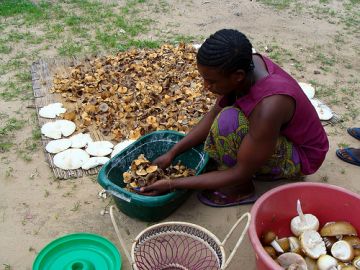Forests and trees for adaptation: the 6 main stories

Research and practice across different forest and tree ecosystems have provided substantial evidence on the importance of these ecosystems for the adaptation of people to climate change.
Six main stories emerge:
Provision of safety nets to local communities facing climatic threats
Forests provide important safety nets to local communities, which help them cope with climate shocks. When crops fail due to drought or assets are lost due to floods, communities sell forest and tree products for income (e.g. timber, fuelwood, NTFPs), while they also consume certain products directly as food intake (e.g. mushrooms, sago, fruits, bushmeat). Fodder from trees helps ensure the survival of livestock for several months when drought strikes. Forests products are less affected by climate variability and extremes than crops or not at the same time. They are thus crucial to the resilience of local livelihoods.
Protection of agricultural production from climate variability
Trees in agriculture regulate soil, water and microclimate, and protect agricultural production from climate variability. Crops grown in agroforestry systems are more resilient to drought, excess of precipitation, and temperature fluctuations and extremes. For example, research in Africa shows that nitrogen-fixing trees make agriculture more drought-resilient due to improvements in soil nutrients and water infiltration.
Reduction of risks related to water scarcity and floods
Forests contribute to regulating river flows (base flows during dry seasons and peak flows during rainfall events), minimizing risks related to water scarcity and floods. For example, in Flores, Indonesia, tropical forested watersheds have been shown to increase base flow and reduce the impacts of drought on downstream agrarian communities.
Protection of coastal settlements from climate extremes & sea-level rise
Coastal forests such as mangroves contribute to disaster risk reduction related to climate extremes (e.g. storms, cyclones) and sea-level rise (e.g. coastal flooding). Coastal settlements with mangroves in their proximity incur less damage from such events than settlements without mangroves, as research in India and Vietnam has shown.

Mangrove restoration can form part of disaster risk reduction strategies in coastal areas. Photo by Daniel Murdiyarso/CIFOR.
Increasing urban resilience to heat waves & floods
Urban forests and trees can provide shading, evaporative cooling and rainwater interception, storage and infiltration services in cities. They can play a significant role in urban adaptation to climate variability and change, for example by reducing temperatures during heat waves.
Influencing regional precipitation patterns
Tropical forests can have a cooling effect in the region through increased evaporation and cloud cover and influence precipitations through water pumping and rainfall recycling. This influence can be over large distances: land-use change in the humid tropics can influence precipitation in the middle and higher latitudes. In a perspective of adaptation to climate change, this role of forests is crucial but still controversial.
(0) Comments
There is no content